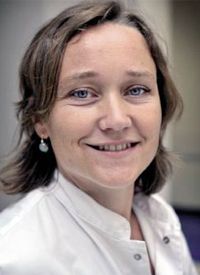Antibodies From AML Survivors Used to Treat AML Patients
Survivors of acute myeloid leukemia (AML) produce antibodies that kill leukemia cells following allogeneic hematopoietic stem cell transplantation (HSCT) that can be used to treat other patients with AML.
Mette D. Hazenberg, MD, PhD

Mette D. Hazenberg, MD, PhD
Survivors of acute myeloid leukemia (AML) produce antibodies that kill leukemia cells following allogeneic hematopoietic stem cell transplantation (HSCT) that can be used to treat other patients with AML.
“Patients who survive AML after allogeneic HSCT produce AML-specific antibodies to really unexpected targets, [including] the U5 snRNP200 complex,” lead study author Mette Hazenberg, MD, PhD, said when presenting the data at the 2016 European Hematology Association (EHA) Congress.
“Interestingly, when these antibodies bind to this complex, they actually kill the target cellthey kill the leukemic cells. This is a novel phenomenon and we think we can develop this further into novel therapies,” added Hazenberg, who is one of the principal investigators at the Academisch Medisch Centrum in Amsterdam, The Netherlands.
Patients with AML can be cured with HSCT when the immune system of the donor generates a strong graft versus leukemia (GvL) response. Previous research has determined the contribution of T cells and natural killer (NK) cells to GvL immune responses; however, the role of B cells in this process is less understood. With this study, Hazenberg et al examined antibodies produced by donor-derived B cells to determine their role in GvL responses.
The study involved 5 patients with high-risk AML who had a potent GvL response after allogeneic HSCT, remaining disease-free for more than 5 years. The researchers isolated memory B cells from the patients’ peripheral blood that was acquired 2-years following the stem-cell transplant. To establish antibody-producing clonal B cell lines, the isolated B-cells were transduced with Bcl-6 and Bcl-xL.
Using immunoprecipitation and mass-spectometry, Hazenberg et al screened the B cell lines and identified 17 antibodies that specifically bound to surface antigens on AML cell lines and blasts that had been isolated from patients in their clinic.
“These antibodies were really selective because they only bound to leukemic cellsblasts and cell lines—but not healthy cells,” said Hazenberg.
Seven of the 17 donor-derived antibodies recognized the U5 snRNP200 complex, which is part of the spliceosome found in the nucleus of healthy cells but located on the cell membrane of AML sells. Antibodies specific to the U5 snRNP200 complex were discovered in 4 of the 5 AML patients screened.
Both in vitro and in an AML mouse model, the antibodies specific to the U5 snRNP200 complex destroyed leukemia cells. “Cell death was induced in the absence of cytotoxic leukocytes or of complement, through a nonapoptotic process that depended on destabilization of the cytoskeleton as cell death could be blocked by incubation of the target cells with cytochalasin D, an actin polymerization inhibitor,” Hazenberg et al wrote in their EHA abstract.
The early-phase research with these antibodiesincluding an additional mouse model—is continuing, with the intent of starting human clinical trials soon.
When asked at EHA about the ideal patient population for such a trial, Hazenberg responded, “There are many patients with AML who cannot receive the standard treatment, such as elderly patients or patients who already received a lot of chemotherapy. I think you would have to start with those types of patients who no longer have other options.”
She also hinted at the potential for combination trials. “In the mice, we saw that these antibodies, by themselves, killed the leukemia, but of course you can also think of combination therapy in which you add this antibody to existing forms of chemotherapy.”
Reference:
Hazenberg M , Gillissen M, Martijn Kedde M, et al. Acute myeloid leukemia (AML) patients cured after allogeneic hematopoietic stem cell transplantation generate tumor-specific cytotoxic antibodies that kill AML blasts. Presented at: 2016 European Hematology Association Congress; June 9-12, 2016; Copenhagen, Denmark. Abstract S124.